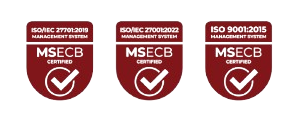From bustling cities to remote villages, the shift from paper-based to digital identity enrolment solutions is reshaping how countries manage their citizens’ identities. This transition brings with it a host of advantages, including cost reduction, increased accessibility, and improved data accuracy.
In this essay, we will delve into the benefits of digital identity enrolment solutions in Africa and explore practical applications, focusing on the groundbreaking work of Seamfix, a digital enrolment partner driving Nigeria’s NIN (National Identification Number) enrollment initiative.
The Need for Efficient Identity Enrollment Solutions in Africa
Africa is experiencing a rapid surge in population, with projections indicating that the continent’s populace will reach a staggering
2.5 billion by 2050. This exponential growth places immense pressure on governments to establish efficient identity enrolment solutions for their citizens. A robust system for registering and managing identities is essential for effective planning and implementation of social, economic, and political programs.
Inclusivity and Accessibility: Breaking down barriers
Many African countries still rely on outdated, paper-based systems for identity enrolment, which often exclude significant portions of the population, especially those in remote rural areas who struggle to access enrolment centres. Digital solutions hold the promise of bridging this gap, making identity registration more inclusive and accessible to all citizens, regardless of their geographic location.
For instance, the Huduma Namba program, launched by the Kenyan government in 2014, exemplifies the power of digital identity databases. This national initiative enables identity verification for various purposes, such as accessing government services, opening bank accounts, or obtaining driver’s licenses. Crucially, the program has successfully enrolled people in rural areas, with over
50 million individuals registered as of March 2023, and a significant majority, approximately 70%, residing in rural regions.
Fraud and Identity Theft Prevention
Paper-based systems are vulnerable to fraud and identity theft, posing substantial financial risks to individuals and governments alike. Digital identity enrolment solutions provide enhanced security and protection against these threats, ensuring the integrity of personal data and safeguarding public resources.
A notable case is Ghana’s experience with the
National Identification Card (NIC) program, initially a paper-based system intended to facilitate better citizen tracking and access to government services. Regrettably, the NIC program was plagued by fraud, exposing thousands of cases where NIC cards were issued using fake or stolen identities. These fraudulent activities granted unauthorized individuals access to government services, including healthcare and education.
Responding to this crisis, the Ghanaian government transitioned to a digital identity enrolment system that leverages biometric data such as fingerprints and facial recognition. This digital system presents significantly higher barriers to fraud, making it considerably more challenging for individuals to exploit the system.
The Advantages of Digital Identity Enrolment Solutions
Cost-Effectiveness: Unlocking Savings and Efficiency
By eliminating the need for physical storage and reducing data entry errors, these digital systems enable governments to operate more efficiently and optimize their use of resources. Additionally, automation within digital systems reduces the reliance on extensive staffing, streamlining operations and reducing labour costs.
For instance, the
World Bank conducted a study on the National Identity System (NIS) in Kenya, revealing that the implementation of this digital solution saved the Kenyan government $100 million annually in fraud prevention and corruption-related expenses. The study also highlighted increased access to government services, particularly for citizens residing in rural areas.
Data Accuracy and Reliability: Empowering Informed Decision-Making
Digital systems excel in maintaining data accuracy and reliability, surpassing the capabilities of paper-based systems. By capturing, storing, and accessing information electronically, the risk of errors is significantly reduced, ensuring that data remains up-to-date and precise. This enhanced accuracy is crucial for effective service delivery, policymaking, and resource allocation.
Consider Rwanda’s adoption of a digital system to track the distribution of food aid to refugees. The
Refugee Food Security Information System (RefSIS) employs a mobile app to collect data on the number of refugees, their specific food requirements, and the distribution of food aid.
Before RefSIS, the government relied on a paper-based system that often led to data loss or misreporting. As a result, some refugees were not receiving the necessary food supplies. The digital system rectified this issue by introducing accurate and efficient data management.
Scalability and Flexibility: Adapting to Changing Needs
Digital identity enrolment solutions are easily scalable, allowing governments to accommodate the rapid population growth observed across Africa. Furthermore, these systems possess the flexibility to adapt to a country’s evolving requirements, incorporating new features or expanding their scope to encompass additional services.
In South Africa, the government utilizes a digital identity system to register citizens for the national ID card. With an anticipated registration of over 56 million citizens by 2024, this digital system proves its capacity for scaling up and meeting the needs of a growing population.
Interoperability and Integration: Seamless Data Sharing
Digital systems can be designed to be interoperable and integrated with other government systems and databases. This seamless integration facilitates efficient data sharing, enabling governments to provide comprehensive services to their citizens.
Rwanda’s digital health system,
Irembo, exemplifies the benefits of such integration. Through Irembo, citizens can access various health services online, including appointment bookings, test result checks, and medical bill payments. This system seamlessly interfaces with other government systems and databases, ensuring that citizens can access their information from multiple sources.
For instance, when citizens apply for a passport, Irembo pulls their information from the national ID database. This integration not only saves time but also minimizes the risk of errors, creating a more efficient and effective healthcare system.
Practical Examples in Africa
Nigeria’s NIN Enrollment Drive with Seamfix
A standout example of digital identity enrolment in action is the partnership between the Nigerian government and Seamfix, a prominent African technology company. Seamfix developed an Android enrolment software that powered the identity enrollment of over 100 million Nigerians, significantly streamlining the process and contributing to the success of the NIN enrollment initiative.
Ghana’s National Identification Authority (NIA)
The Ghanaian government, in collaboration with the National Identification Authority (NIA), implemented a biometric registration system to issue the Ghana Card, a national ID card for citizens and residents. This digital system has remarkably improved the efficiency of the registration process and significantly increased the number of registered individuals in the country.
Kenya’s National Integrated Identity Management System (NIIMS)
Kenya’s NIIMS, commonly known as Huduma Namba, represents a digital identity enrolment solution that aims to create a centralized, digital database of all Kenyan citizens and residents. Leveraging digital technology, NIIMS has streamlined the enrolment process, providing the Kenyan government with accurate and reliable data on its population.
Key Components of Digital Identity Enrolment Solutions
Biometric Technology
Biometric technology, such as fingerprint, facial, and iris recognition, plays a crucial role in digital identity enrolment solutions. This technology enables the unique identification of individuals based on their physical or behavioural characteristics, enhancing accuracy and security.
Mobile Enrollment Units
Mobile registration units are indispensable for bringing digital identity enrolment solutions to remote and underserved areas. Equipped with the necessary hardware and software, these units capture and transmit biometric data to a central database.
Seamfix’s Android software, for example, boasts biometric capabilities that capture high-quality facial images and fingerprints both offline and online, and document scanning, facilitating enrolment even in areas with limited connectivity.
Cloud-Based Storage and Data Management
Cloud-based storage and data management systems are vital for ensuring the security, accessibility, and scalability of digital identity enrolment solutions. By storing data in the cloud, governments can minimize the risk of data loss and ensure its availability when needed.
User-Friendly Interfaces
User-friendly interfaces are essential for promoting the widespread adoption of digital identity enrolment solutions. By designing systems that are easy to use, governments can ensure that citizens and officials alike can quickly and efficiently navigate the enrolment process.
Choosing the Right Digital Solution for Your Organization.
Although they differ in features and functions, some common types of identity enrolment solutions include:
– Self Service applications that enable applicants to apply online
– Mobile enrolment software enables field agents to capture enrollment data even in remote areas.
– Dedicated enrolment kiosks that are available at specified locations
– Partner enrolment systems, where partners, such as banks, provide digital enrollment services.
When selecting a digital identity enrolment solution, several factors must be considered. Firstly, the chosen solution should align with your organization’s goals and objectives. For instance, if the primary aim is cost reduction, a mobile application may be the optimal choice as it eliminates the need for dedicated enrolment kiosks.
Secondly, the solution should prioritize user-friendliness and convenience. The application process should be straightforward and accessible, even for individuals with limited technological proficiency. Additionally, robust security features must be in place to safeguard sensitive data.
Conclusion
By investing in digital infrastructure and collaborating with private sector partners like Seamfix, African governments can usher in a new era of modern and inclusive identity management. These digital solutions offer efficiency, cost-effectiveness, scalability, and enhanced data security, providing a strong foundation for economic growth, social development, and improved governance.
In conclusion, the transition from paper-based to digital identity enrolment solutions is revolutionizing how African countries manage their citizens’ identities. With their numerous advantages, these solutions address the challenges posed by rapid population growth, accessibility limitations, and data security concerns. As more countries across Africa embrace digital identity management, the continent is poised to become a global leader in this field, laying the groundwork for a more prosperous and connected future.
Book a
discovery call with our sales team today to explore how our enrolment solutions can meet your organization’s specific needs and propel you towards a more efficient and secure identity management system.









